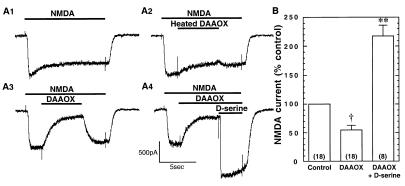Figure 5.
DAAOX inhibition and d-serine reversal of NMDA-evoked currents in cultured hippocampal neurons. Solutions were applied by using a multibarrel fast-perfusion device. Tetrodotoxin (1 μM) was present in the perfusion media. (A1) Representative current evoked by 10 μM NMDA. (A2) Heated DAAOX minimally affects the current amplitude. (A3) DAAOX (10 μg/ml) produces a 75% reduction in the current amplitude that recovers slowly upon termination of the DAAOX perfusion. (A4) d-Serine (100 μM) rapidly overcomes the DAAOX and induces a marked potentiation of the NMDA-evoked current. (B) Summary of data from 18 experiments similar to that of A. Acute application of DAAOX produced a significant decrease in the magnitude of inward current (†, P = 0.0014), whereas heat-inactivated DAAOX application did not alter significantly NMDA-evoked current (not shown). DAAOX-induced inhibition of NMDA current is reversed and the current is enhanced further by d-serine (**, P < 0.0001). Total number of recordings for each condition is indicated in parentheses. Bars indicate mean ± SEM of the maximal response expressed as a percentage of control. Statistical significance was evaluated by using ANOVA analysis followed by Scheffé posthoc comparison.

